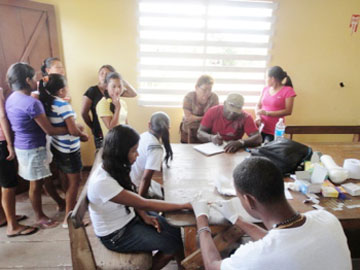The emergency medical team deployed to Region Seven last Thursday to investigate claims of a malaria outbreak at Waramadong found a few imported cases but no epidemic.
According to a Government Information Agency (GINA) press release issued last Friday, the team said that after conducting mass smears in the community it found a few cases of the disease, which had been imported into the community but was not a public health threat.

“The team conducted 369 smears, 14 of which were positive, most of them from Jawalla, and one each from Imbaimadai, Isseneru, and Koko,” GINA said, adding that a 26-year-old woman also tested positive for the disease.
Smears were also done in the homes that the infected persons visited. Students who had spent their Christmas vacation at their respective villages in Region Seven also recently returned to the dormitory at Waramadong.
Director of Regional Health Services (RHS) Dr Irv Chan, who was a part of the emergency team, was quoted as saying that the RHS and other departments will be monitoring the situation. He also said his department is in discussions with the National Malaria Programme to have another team return to the area soon.
Dr Chan also said that there is a need for impregnated bed nets and that these will be distributed over time. He also said that the RHS will be addressing other health needs in the community.
The Vector Services Unit has embarked on a large-scale distribution of 50,000 Long Lasting Impregnated Nets to mining and other vulnerable communities, starting January 15. GINA said to date over 28,000 nets have been handed over to Regions 7 and 8, the Ministry of Public Works, the Guyana Gold and Diamond Miners’ Associa-tion, the Guyana Forestry Commission, the Guyana Geology and Mines Com-mission, the Forest Producers Association and the Ministry of Natural Resources and the Environment.
School leaders were also encouraged to work closely with the health department in the region and a clinic has been established to expand services to the wider community.
Dr Reyaud Rahaman, Government Medical Officer, indicated that the support given by the ministry and the Guyana Defence Force aided the pace of the response effort.
On being alerted to reports of an outbreak, Minister of Health Dr Bheri Ramsaran solicited the assistance of the GDF and the next day the army sky-van transported a team including four microscopists, bed nets and equipment for spraying to Waramadong.
The team had planned to spend one day in the community but took the decision to overnight to complete testing.
Dr Rahaman said a vector control unit was established within the village council. Councillors were taught the symptoms of the disease and how to mix insecticides to prevent its spread.
The community also benefited from a seminar which distributed over 200 nets to vulnerable groups, such as pregnant women, children under five-years-old and to the school.
The vector control unit was also given a microscope and several persons have been selected to undergo six weeks of training in microscopy.
According to Dr Rahaman, 90% of the school’s population did not have nets “so they have a mosquito problem but not a malaria problem.” Additionally,




